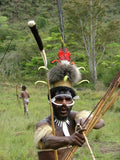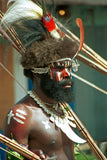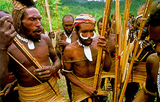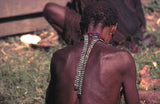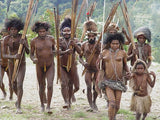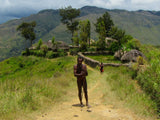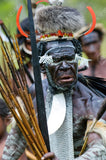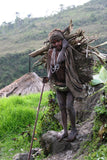EXTREMELY RARE YALI TRIBE (CANNIBAL) “BIG MAN” MIKAK TRIDACNA GIGAS NECKLACE WITH WOVEN BARK HAND-TWISTED TWINE, VALUABLE CURRENCY, HIGHLANDS, CENTRAL IRIAN JAYA, WEST NEW GUINEA, MID-20th CENTURY, CIRCA 1960’S, PRIVATE COLLECTION
Very rare Museum piece: Tridacna shell decorations, attached to a necklace with many Nassa shells (in trade, often called a money belt) covering a plaited hand twisted & hand woven bark twine band, mid-20th century, circa 1960s. Yali people, central Irian Jaya, West New Guinea. Great Patina.
Band: 37" with 9 1/2" shell drop.
The Yali tribes) live in the remote interior of the western half of New Guinea in the Baliem River region and mountains. Due to their relative isolation the Yali were virtually unknown until the late 1960s.
This outstanding old spoon-shaped necklace, made from a giant Tridacna Clamshell called mikak with a woven band surmounted with numerous nassa shells, was acquired by trade with coastal tribes. It was worn as an emblem of prestige by elder warriors. The side of the shells with the brownish patina – wonderfully aged from years of wear – was worn against the chest of the bearer while the lighter underside faced outward.
Necklaces from this tribe and of this design type, which resembles a similar type worn by Marind-Anim warriors, are rare and mostly in private collections.
The Yali tribe belonged to the most dreaded cannibals of New Guinea. Despite the fact that mature men are rarely taller than 5 ft and have never been head-hunters, they are respected by their enemies. As a result, tribes did not mix because of their fears from each other, and each developed different languages.
The Yali totally eradicated their enemies, they did not only eat their bodies but grounded the bones to dust and threw them in the valley so that the victim could never return. People in near-by villages were not only killed for revenge but just for their meat!
For centuries, the men of the Highlands have worn nothing, daily, but their traditional penis gourd or phallocrypt and various and now rare pectoral ornaments difficult to acquire today.
The men are much more concerned about their beauty than women, therefore, they are extremely fond of body ornamentation and decorate themselves elaborately with feathers and shells, especially for celebrations (traditional headdresses are made of cockerel feathers in a fetching circular crown). Beauty is only a matter of taste and here the ornamentation can be rather elaborate. Warrior’s heads can be adorned with furs, shells, animal fangs, teeth and bird feathers.
Although the mountainous highlands and their rainforests can get very cold, they wear nothing else but these few pieces of clothing, except for a few feathers or perhaps a boar’s tusk through their nose. Since they remain practically naked, coating their bodies with insulating pig fat helps keep warm in the mountain climate.
To this day, the tribes reject new ways and any form of clothing, other than the grass fiber skirt for the women and the chest ornaments and horim or koteka for the man (gourd penis cover).
Tridacna gigas is the largest mollusk in the world.


















































